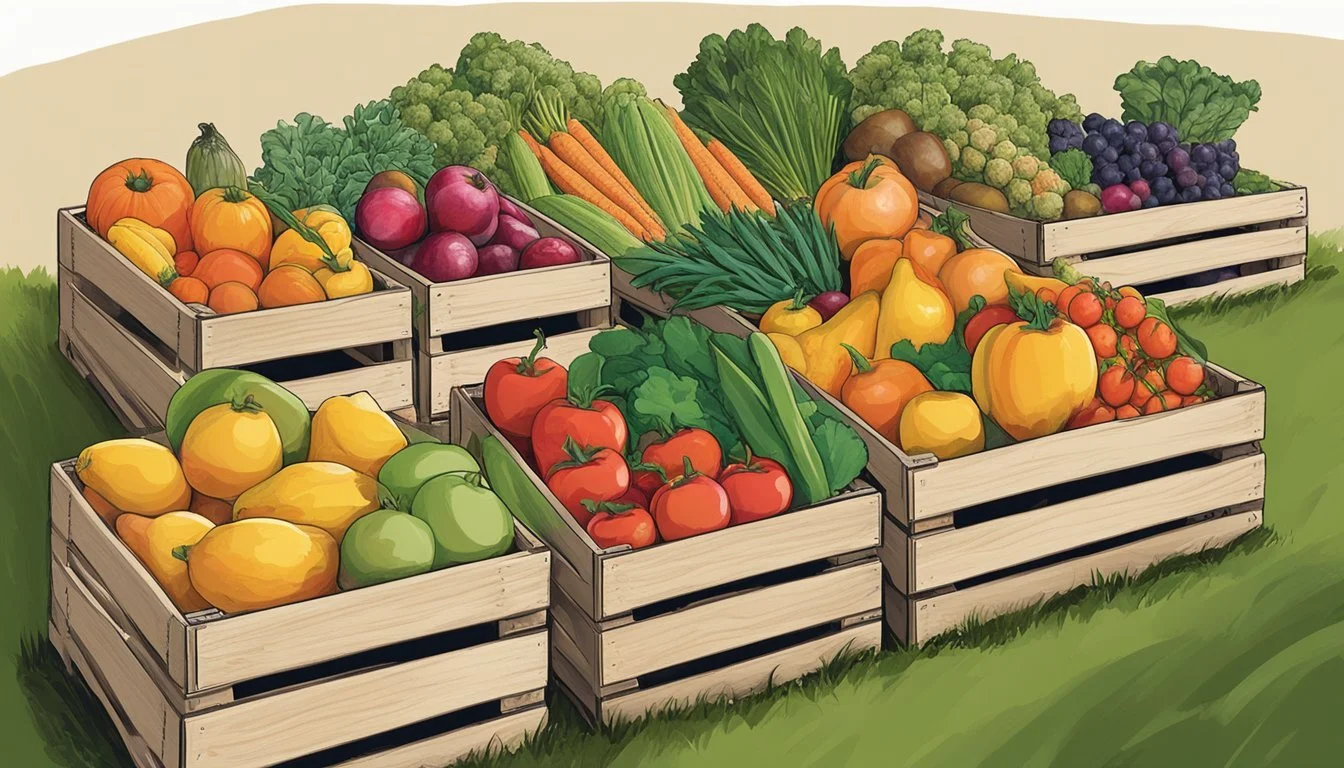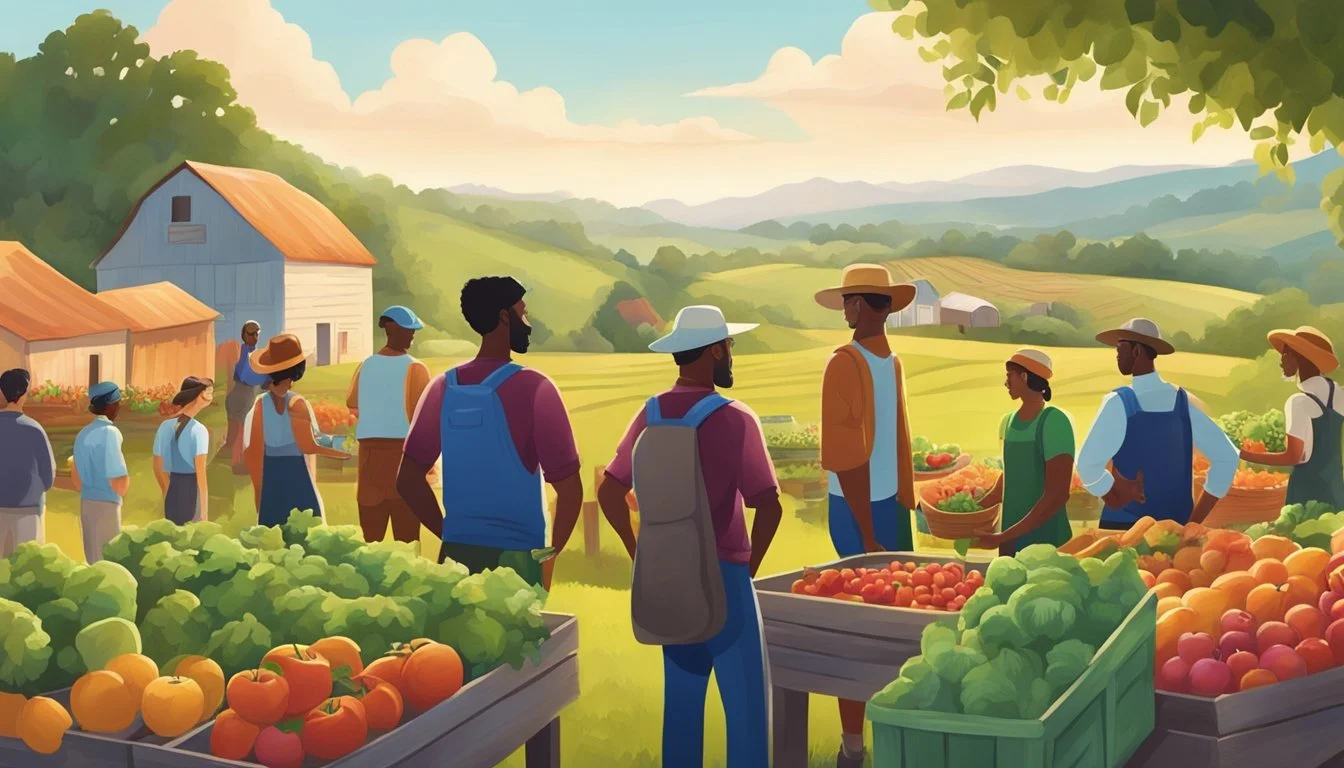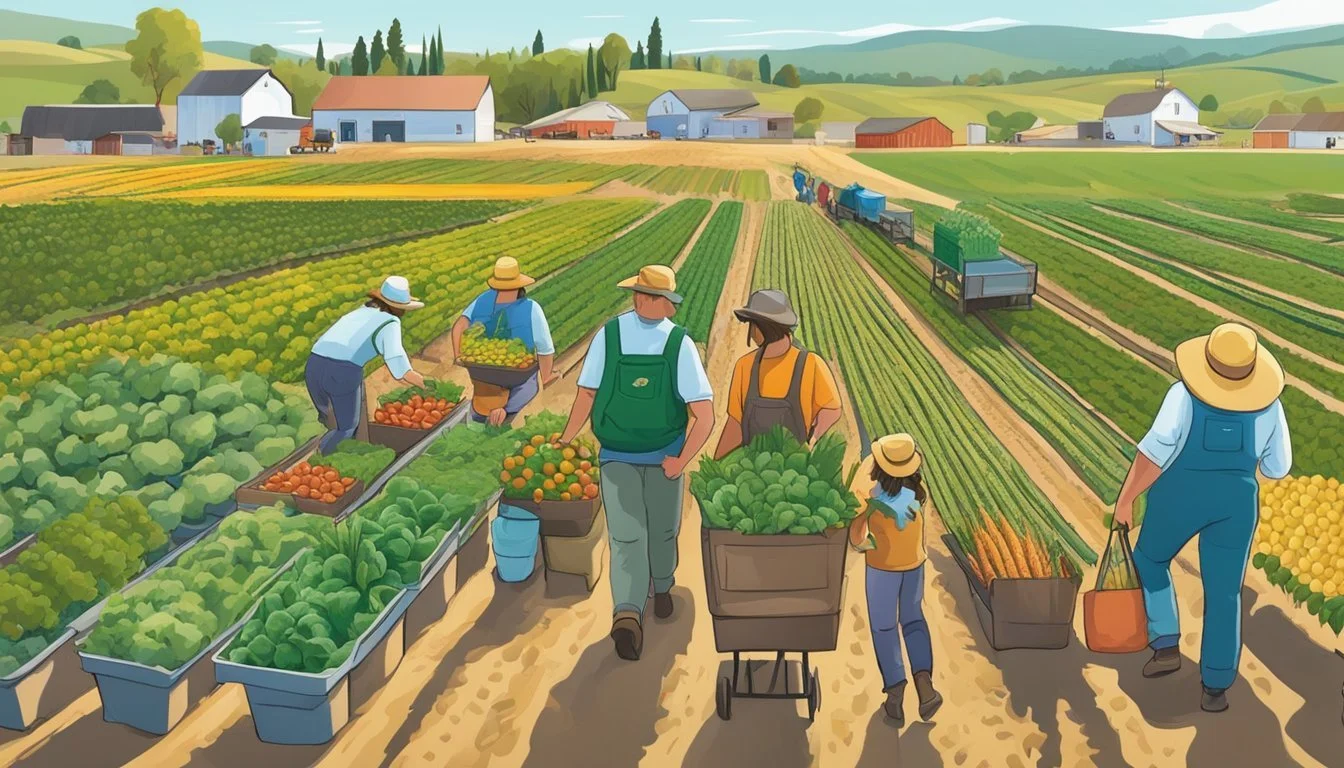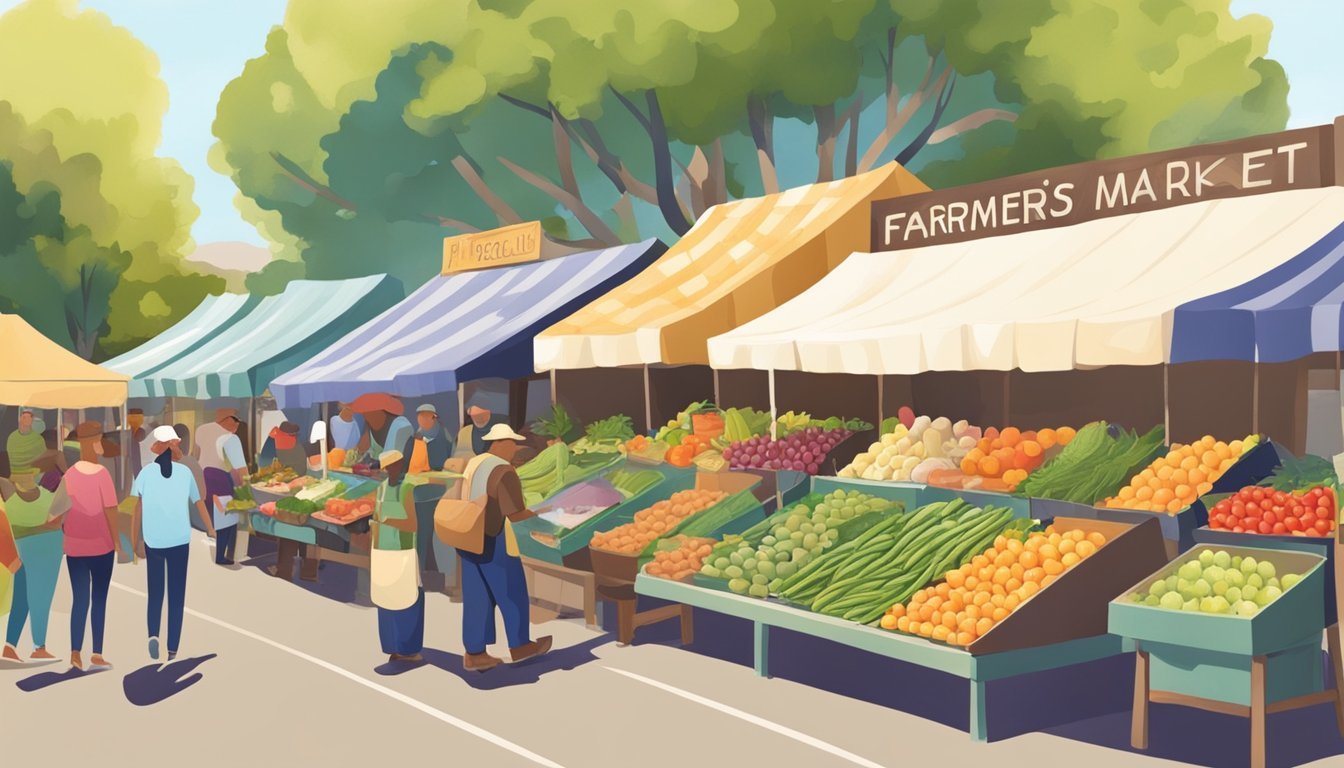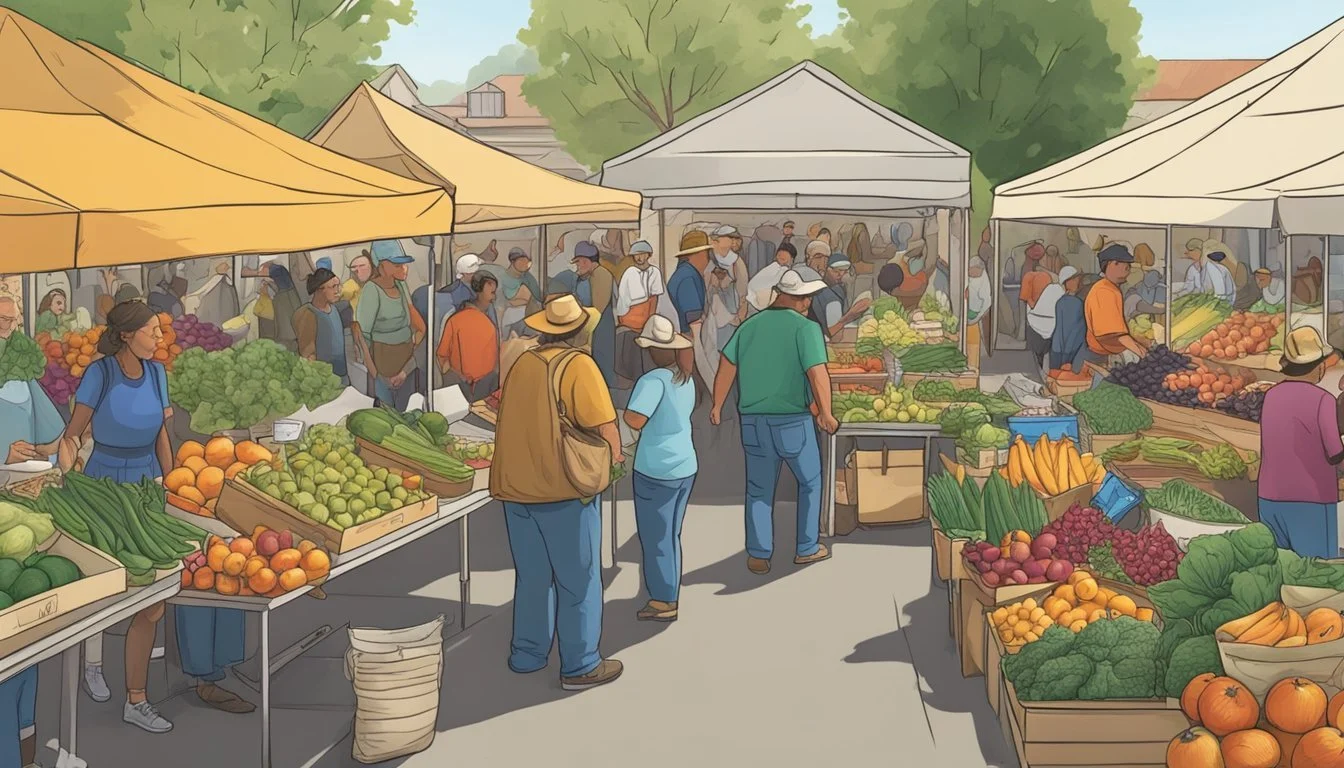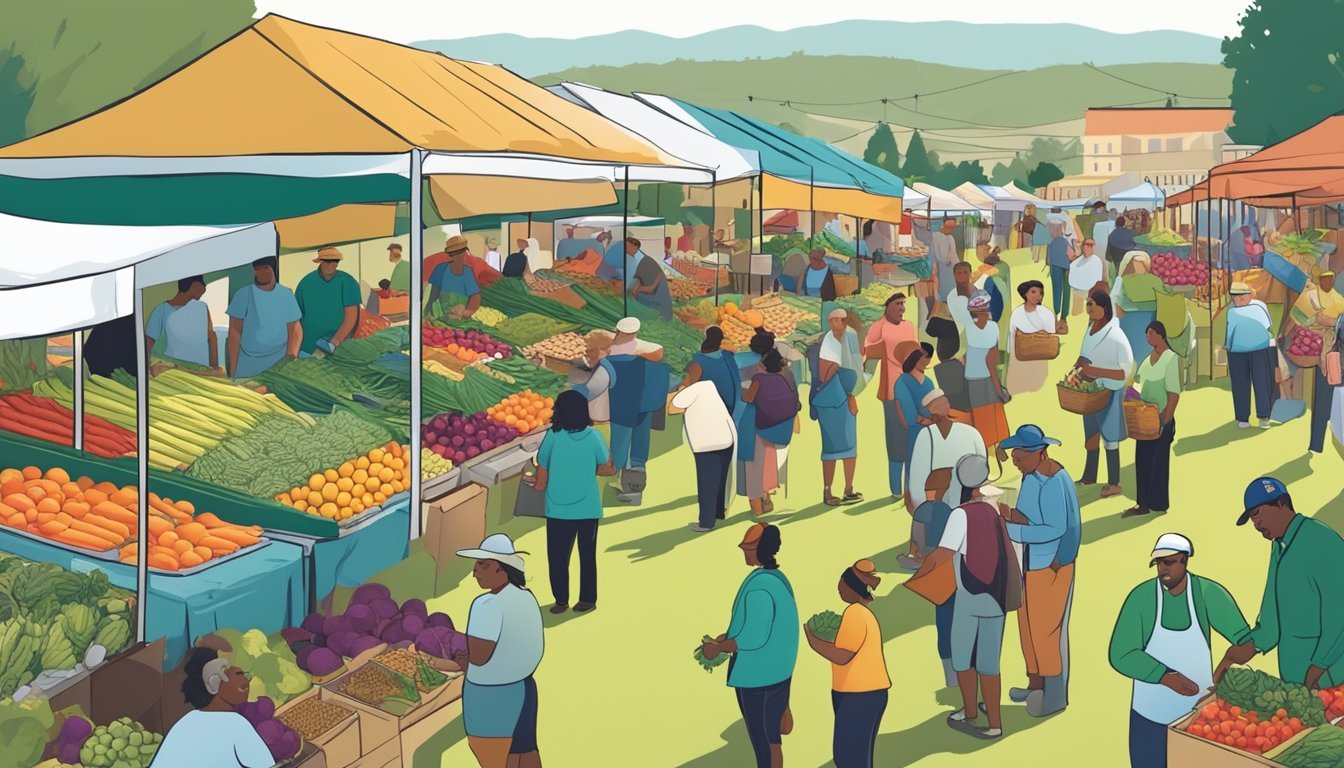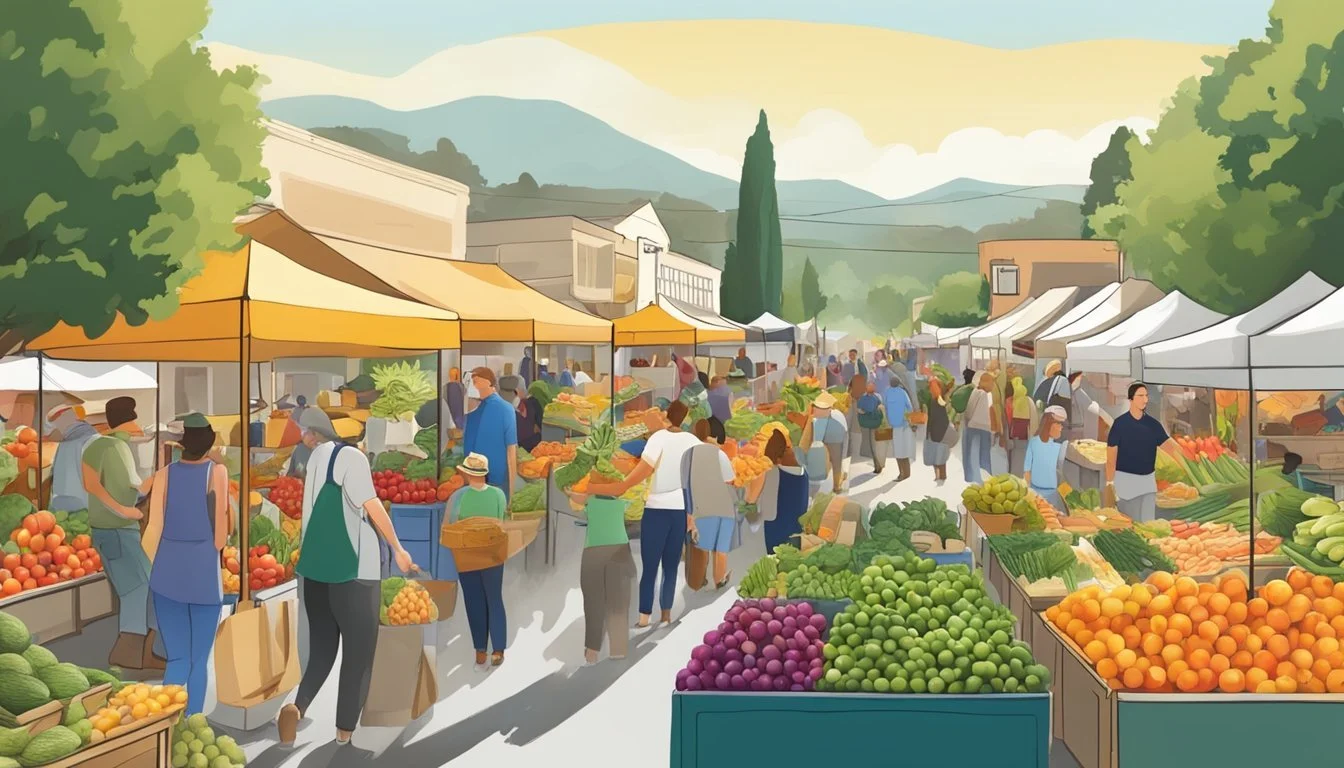Community Supported Agriculture (CSA) in Antioch, CA
Benefits and How to Get Involved
Community Supported Agriculture, commonly known as CSA, is a model of farming and food distribution that has rooted itself in the ethos of Antioch, California, along with numerous other cities across the nation. CSA taps into the bond between local farmers and community members, fostering a direct-to-consumer approach that benefits both parties. Members of the community purchase "shares" from local farms, investing upfront in the agricultural process, which in turn grants them access to a portion of the season's harvest.
The CSA model in Antioch enables residents to source their food locally, ensuring freshness and reducing the carbon footprint associated with long-distance transportation of produce. It's a cyclical exchange that bolsters the local economy and deepens relationships between residents and the individuals who grow their food. Subscribers typically receive a weekly or bi-weekly box of a farm's bounty, which may vary from vegetables and fruits to other products such as honey, eggs, and dairy, depending on the farm's offerings.
This practice of agriculture represents more than a method of procurement; it embodies a commitment to sustainable living and community well-being. Through participation in a CSA, Antioch's residents contribute to the preservation of local farmland and advocate for the importance of relying on and supporting neighboring growers. The reliability on seasonally available goods also encourages a nutritious and varied diet, further stimulating consciousness about the environment and nutrition.
History and Principles of CSA
This section explores the evolution of Community Supported Agriculture (CSA) from its origins to the diverse models in existence today, emphasizing its foundational concepts and relationship with the community and environment.
Origins of CSA
Community Supported Agriculture began as a collaborative approach to farming in the late 1970s and early 1980s. It evolved in response to the negative impacts of industrialized agriculture, striving to establish a more local food economy. The first CSA projects in the United States were attributed to European influences and were established in 1986 by Indian Line CSA in Massachusetts and Temple-Wilton Community Farm in New Hampshire. These initiatives set the stage for a rapidly growing movement that would spread across the country, including California.
Core Concepts
At the heart of CSA are several core principles:
Shared Risk and Reward: Both the farmers and community members (shareholders) assume the costs of food production and share the bounty of the harvest.
Agroecology: CSA supports agricultural methods that are environmentally sound, fostering soil health and biodiversity.
Health and Nutrition: The proximity of farms to consumers ensures fresher produce, enhancing the nutritional value of food and supporting the health of the community.
Community Engagement: A CSA fosters direct connections between farmers and community members, creating a deeper understanding of food production and strengthening local economies.
CSA Models
CSA models vary widely but can be generally categorized into the following types:
Traditional CSA: Members pay in advance for a season's worth of produce, receiving periodic shares of the harvest.
Market-Style CSA: Members have more choice and flexibility, picking up produce similar to shopping at a farmers' market.
Subscription CSA: Akin to a regular subscription service, where a set box of goods is delivered on a schedule.
California has seen a significant adoption of these models, with each model leveraging the state's diverse agricultural capacity to support the development of robust local food systems. This adaptation of the CSA concept to local conditions has helped shape the movement's effectiveness in promoting sustainable agriculture in the region.
CSA Benefits
Community Supported Agriculture brings tangible perks to stakeholders and the environment. It promotes health through organic and seasonal produce, fosters a sense of community, and aids in the creation of sustainable food systems.
Advantages for Consumers
Consumers benefit directly from CSAs by gaining access to fresh, local food. They often receive organic, seasonal produce that surpasses the usual grocery store fare in both taste and nutritional value. With regular deliveries, they can enjoy a diversity of produce timed with the natural growing cycle of the region.
Health: Fresh, nutrient-rich produce supports a healthy diet.
Sense of Community: CSAs typically encourage direct relationships between consumers and farmers, fostering community ties.
Advantages for Farmers
Farmers gain a dedicated market for their goods by partnering with CSA members. This model provides them with financial stability, as the money from membership shares helps cover initial seasonal expenses. They are also able to receive feedback directly from consumers, which can guide crop selections and farming practices.
Stable Income: Prepaid CSA shares provide reliable revenue.
Direct Consumer Relationship: Immediate feedback helps refine their offerings.
Environmental Benefits
CSAs support environmental benefits by favoring sustainable practices. The use of organic farming methods often means fewer chemicals, promoting soil health and biodiversity. Additionally, local distribution reduces carbon footprints when compared to traditional supermarket supply chains, which often involve long-distance transportation.
Sustainable Food Systems: CSAs help to minimize waste and reduce transportation emissions.
Organic Practices: These often enhance local biodiversity and soil quality.
Starting a CSA in Antioch
When considering the establishment of a CSA in Antioch, it is vital for prospective farmers to gauge community interest, establish a strong membership base, and deploy effective business and marketing strategies to ensure a successful operation that benefits both the producer and the local economy.
Understanding Local Demand
To assess what Antioch's community desires, thorough research is essential. Surveys and discussions with local residents can reveal preferences for organic produce or specific crops. Antioch's demographic information is useful to tailor CSA offerings accordingly. The local demand directly influences the number and size of shares the CSA will offer.
Farmers and Membership
Developing a strong relationship between a farmer and members is the cornerstone of any CSA. In Antioch, farmers should ensure transparency regarding farming practices and offer educational opportunities about the benefits of supporting local agriculture. Membership options can range from full to half shares, accommodating both small and large households. It's crucial to set realistic goals for membership numbers and to maintain consistent communication with members throughout the season.
Business and Marketing Strategies
For a CSA in Antioch to thrive, smart business and marketing strategies are indispensable. Direct marketing efforts like creating a robust online presence, participating in local events, and leveraging social media can significantly increase visibility. Traditional methods such as flyers and local newspaper ads should not be underestimated. Moreover, written agreements outlining the CSA structure provide clarity and security for both parties.
By focusing on understanding local demand, establishing a durable farmer-member relationship, and employing tailored marketing tactics, a CSA in Antioch can fortify its position in the local economy and become a viable business contributing to the community's sustainable future.
CSA Operations
Community Supported Agriculture in Antioch reflects a symbiotic relationship between consumers and producers, emphasizing advanced planning, resource allocation, and shared risks and benefits.
Managing a Farm
Managing a farm within a CSA model requires strategic coordination and a deep understanding of sustainable agricultural practices. Farmers are tasked with overseeing the day-to-day operations, ensuring that resources such as seeds, equipment, and labor are utilized effectively. One key consideration includes weather patterns, as these can significantly impact yield. Knowledgeable farmers use this data to make informed decisions about crop rotations and land management, providing shares to their members each season reliably.
Crop Planning and Harvest
Crop planning is a crucial step in CSA operations, with farmers needing to decide which vegetables and fruits to grow and in what quantities, based on member preferences and seasonal conditions. This includes meticulous scheduling to maximize harvest output and variety. Harvest time is then a bustling period where the produce must be picked at peak ripeness to ensure the highest quality for CSA members.
Distribution and Logistics
Once the harvest is ready, the distribution phase involves careful logistics. CSA operations in Antioch often include options such as on-farm pickup locations or partnerships with local meal delivery services for home delivery. Distribution strategies are designed to maintain the freshness of produce and meet the different needs of members. The delivery schedule is clearly communicated, often via email or a website, with transparent pricing and any necessary updates or changes due to unforeseen circumstances like unexpected weather.
Member Engagement
Community Supported Agriculture (CSA) in Antioch, CA, enhances member engagement through targeted strategies focused on building community, encouraging feedback for member retention, and by providing a range of participatory opportunities.
Building Community Connections
CSA programs in Antioch place a strong emphasis on fostering connections within the community. Members are not just shareholders in the agricultural produce but also form partnerships that consolidate the local food system. Facilitating events such as local farm visits and harvest festivals, CSAs encourage face-to-face interaction, amplifying a sense of community among members.
Feedback and Retention
Member feedback is integral to the success of a CSA. Surveys are routinely conducted to gauge member satisfaction and to identify areas for improvement. These surveys have a direct impact on retention rates, as they allow the CSA to respond to the community's needs effectively. By adapting to the feedback, CSAs witness higher member retention and persistent engagement.
Volunteerism and Participatory Opportunities
Active participation is a cornerstone of CSA functioning. Members are often given the responsibility to volunteer in various capacities — from assisting in distribution to hosting educational workshops. These participatory opportunities not only increase the members' investment in the CSA but also enhance their understanding of sustainable agriculture and reinforce their responsibilities towards the community and the environment.
Financial Aspects of CSA
Community Supported Agriculture (CSA) in Antioch, CA, operates on a financial structure that can influence the economic viability of local farms. Understanding the dynamics of membership fees, income patterns, and alternative funding options, including SNAP benefits, is essential for both consumers and producers.
Membership Fees and Pricing
In Antioch, CSA members typically pay upfront fees that grant them a subscription to a farm's produce for a season. This payment is referred to as purchasing a "share." Pricing varies depending on the farm's operational costs, the variety of produce, and the length of the subscription. An example pricing structure may be as follows:
Small Share: $300 (suitable for individuals or small families)
Large Share: $500 (ideal for larger families or those who wish to can or freeze produce)
Income and Sustainability
A CSA farm's income predominantly relies on these membership fees collected at the start of each season. This model provides farmers with a reliable source of income before the harvest, helping them plan and sustain their operations. For example, a farm that sells 100 large shares at $500 each at the beginning of the season would secure an income of $50,000 to cover the production costs and investments needed to grow the crops.
Alternative Funding and SNAP
Alternative funding, including accepting SNAP (Supplemental Nutrition Assistance Program) benefits, can broaden a CSA farm's customer base. In Antioch, CSA programs may be SNAP-eligible, allowing lower-income families to afford fresh, local produce. By integrating SNAP:
They enhance the economic viability by tapping into a larger market.
They promote inclusivity and access to high-quality food.
However, the farm must navigate additional administrative requirements to process these benefits.
Policy and Regulations
In Antioch, CA, Community Supported Agriculture (CSA) operations must adhere to a set of policies and regulations designed to ensure safety, sustainability, and fair commerce. These regulations are guided by federal, state, and local standards, including those set forth by the Environmental Protection Agency (EPA) and the National Agricultural Statistics Service. It is also crucial that these programs navigate legal considerations specific to CSA models.
Local and National Standards
Local and national standards govern CSA practices to maintain a structured and equitable system for both producers and consumers. In California, CSA program registration involves compliance with the California Direct Marketing Act, which includes reporting to the California Department of Food and Agriculture (CDFA). On a national level, CSA farms report their earnings and practices to the National Agricultural Statistics Service, ensuring transparency and adherence to direct-to-consumer sales metrics.
EPA and Agricultural Guidelines
The Environmental Protection Agency (EPA) plays a significant role in regulating the environmental practices of agricultural entities, including CSAs. In California, CSA farms must maintain compliance with:
Clean Water Act: Ensures that the waterways remain free from agricultural runoff.
Endangered Species Act: Protects local biodiversity affected by farming operations.
Worker Protection Standards: Safeguards farmworkers from pesticide exposure.
These guidelines ensure that CSAs contribute to environmental health and safety within their communities.
CSA Legal Considerations
Legal considerations for CSAs in Antioch, CA, include aspects like member agreements, risk-sharing, and volunteer participation. CSA programs often utilize written agreements that detail the obligations and commitments between the farmer and the consumer. Furthermore, CSA business models must carefully address concerns such as:
Sales Contracts: Explicitly stating the terms of produce sales and distribution.
Risk Management: Defining how risks are shared in the event of crop failure.
Securities Law Compliance: Ensuring that shares in the CSA do not constitute a sale of securities.
Legal resources, such as the Legally Resilient CSA Program Guide, can assist farmers in navigating these complexities to maintain lawful operations.
Educational Components
In Antioch, CA, Community Supported Agriculture (CSA) programs contribute significantly to the education of the community by focusing on agricultural research, public health and nutrition, and education on sustainable practices. These CSA programs create avenues for knowledge exchange and learning opportunities, enhancing both agricultural and health outcomes.
Agricultural Research
Community Supported Agriculture initiatives in Antioch provide a platform for conducting agricultural research. Local farmers and researchers collaborate to collect and analyze data on crop yields, pest management, and soil health. This information is vital for refining farming techniques and ensuring the sustainable production of crops.
Data Collection: Methods include field observations and experimental plots within CSA farms.
Analysis: Findings contribute to agricultural knowledge and are shared through CSA networks.
Public Health and Nutrition
CSAs in Antioch also emphasize the importance of public health and nutrition education. They offer resources such as nutrition classes and workshops that educate members on the health benefits of fresh, locally-sourced produce.
Health: Focus on the nutritional impact of vegetables and fruits in diet.
Education: Provision of recipes and cooking demonstrations to encourage whole-food based diets.
Sustainable Practices Education
Education on sustainable practices is a cornerstone of CSA programs in Antioch. Members learn about eco-friendly farming methods, composting, and water conservation, all of which contribute to the resilience of the local food system.
Sustainable Resources: Sharing of best practices and innovations in sustainable agriculture.
Community Impact: Stressing the benefits of reducing the carbon footprint through local sourcing of food and reduced food waste.
Case Studies and Data
This section delineates pertinent case studies, survey data, and research findings that illuminate the impacts and functioning of Community Supported Agriculture (CSA) in Antioch, CA.
Local CSA Success Stories
In Antioch, several CSA farms have established themselves as critical components of the local food system. These farms exemplify the potential for a moral economy where consumers and producers foster a mutually beneficial relationship. A notable case involves Sunrise Farm, whose partnership with local residents has led to a robust CSA program. Through critical cartography and GIS methods, graduate student researchers have mapped the growth of Sunrise Farm's CSA, highlighting its influence in enhancing community access to fresh produce.
Survey Data and Analysis
Survey data collected from CSA members in Antioch provide insights into customer satisfaction and purchasing behaviors. A farmer survey indicated that over 90% of CSA subscribers expressed high levels of satisfaction with the quality and variety of produce offered. Further analysis reveals that grocery purchasers who partake in CSAs demonstrate increased inclination towards supporting alternative food networks, emphasizing the value they place on locally-sourced and ecologically grown produce.
Research Findings
Recent findings from research conducted on CSAs in Antioch underscore the vital role these agricultural models play in sustainable food systems. A published study highlights the balancing act of moral economy versus self-exploitation experienced by CSA farmers, revealing how they navigate economic pressures while upholding values of community and ecological stewardship. Moreover, CSA farms serve as critical information sources, educating consumers about sustainable practices and the benefits of supporting local agriculture.
Challenges and Considerations
Community Supported Agriculture (CSA) in Antioch, California, faces several challenges ranging from environmental concerns to market dynamics. Understanding these issues is key for both the survival of local farms and the satisfaction of CSA members.
Dealing with Weather and Climate
In Antioch, local farmers must navigate weather and climate variations that impact seasonal production. The region's distinct seasons pose threats such as droughts and excessive heat, especially during critical growing periods. Farmers must be proactive in employing strategies to mitigate these risks, considering:
Drought-resistant crops: Choosing varieties that can withstand dry conditions.
Irrigation management: Balancing water use with conservation efforts.
Market Competition and Challenges
The market for CSA shares in Antioch is shaped by competition with conventional stores and other direct-to-consumer models. Local farmers experience pressure to maintain retention rates but also to attract new members amidst a competitive market. They often address these challenges by:
Diversifying offerings: Providing a wide range of products to meet diverse member needs.
Marketing effectively: Utilizing social media and local events to increase visibility.
Member Expectations and Experience
CSA programs hinge on the farm-member relationship, and managing member expectations is crucial. Members may have questions or concerns that need addressing for a satisfactory experience. Surveys indicate that clear communication is critical, including:
Regular updates: Informing members about crop availability and potential disruptions.
Feedback mechanisms: Establishing channels for members to share their experience and provide suggestions.
Maintaining a positive experience strengthens retention and fosters community support, which is essential for the long-term sustainability of CSAs in Antioch.
Local CSA Directory
This section effectively serves as a resource for individuals seeking information on Community Supported Agriculture programs in the Antioch area. It includes specific farm details, product selection, and subscription logistics.
Farm Listings and Profiles
Antioch CSA Innovation Network unites multiple farms committed to sustainable agriculture, working since 2012 to strengthen the local economy. Participants in this network provide comprehensive profiles showcasing their farming practices, location details, and community involvement.
Farm A: Specializes in organic vegetables, established in 2015.
Farm B: Prides itself on a biodynamic approach, member since 2017.
Farm C: Integrates traditional methods with modern technology.
Product Offerings
Each farm offers a variety of products, typically included in a weekly delivery throughout the harvest season. The following items represent the diversity accessible through CSA shares:
Vegetables: A range of seasonal produce including, but not limited to, leafy greens, root vegetables, and heirloom varieties.
Fruits: Season-dependent selections such as berries, stone fruits, and citrus.
Additional Products: Some farms may offer eggs, honey, and artisanal cheeses.
Subscription and Contact Information
Subscriptions to a local CSA generally operate on a seasonal basis, with details and pricing available on farm websites or at local retail outlets.
Contact and Subscription Table:
Farm Name Subscription Season Contact Information Pickup Location(s) Farm A May - October info@farma.com Downtown Antioch, Farm Site Farm B June - September contact@farmb.org Farmers Market, Various Retail Outlets Farm C Year-Round Availability farmc@csanetwork.net On-Site, Local Health Food Stores
Subscribers have the option to choose their preferred pickup location from designated spots such as farm grounds, local markets, or partnered retail outlets.
Recipes and Cooking Tips
Community Supported Agriculture (CSA) in Antioch, CA, offers residents an opportunity to enjoy fresher, local produce, often leading to better flavors and a deeper connection with the food they eat. This section provides guidance on creating meals that highlight the seasonal bounty available through CSAs, with a focus on vegetables, fruits, meats, cheeses, and eggs.
Seasonal Cooking Ideas
Incorporating seasonal ingredients from Antioch's CSA can enhance the natural flavors in home-cooked meals. For spring and summer, dishes might feature strawberries and corn, which can bring sweetness and texture to a variety of recipes. During autumn, roasting broccoli with a dash of olive oil and sea salt brings out a rich, savory flavor that complements the season's cooler weather.
CSA Box Utilization
Efficient use of a CSA box includes understanding how to store and combine different CSA offerings. Here's a quick guide to keeping your ingredients fresh:
Vegetables: Keep root vegetables like carrots and beets in a cool, dark place.
Fruits: Most fruits, such as apples and berries, should be refrigerated.
Leafy greens: Wrap greens in a damp towel and place them in the crisper drawer.
Meal planning around a CSA box also prevents waste. A stir-fry might use up a variety of vegetables, while omelets are perfect for incorporating leftover cheese and veggies.
Cooking with CSA Ingredients
When cooking with CSA ingredients, the freshness of the produce often means that simple preparations can be the most satisfying. For example:
Meat: Light seasoning and proper cooking techniques bring out the natural flavors.
Eggs: Fresh eggs from a CSA can be the star of breakfast dishes or work as a binder in recipes like meatballs.
Remember, cooking with CSA ingredients not only supports local farmers but also provides a platform to experiment with new flavors and recipes, enriching the culinary experience.
Conclusion
Community Supported Agriculture (CSA) represents a sustainable approach to food production and consumption that has positively impacted Antioch, CA. By facilitating direct partnerships between local farmers and community members, CSAs encourage a sense of belonging and vested interest in agricultural success.
Antioch's involvement in CSA allows residents to actively participate in a food system that prioritizes ecological health and contributes to the local economy. Members appreciate fresh, seasonal produce and the peace of mind that comes with knowing the origin of their food.
The advantages of CSA in Antioch include:
Enhanced Community Connection: Encourages relationships between growers and consumers.
Economic Support: Direct sales benefit local farmers financially.
Health Benefits: Access to fresh, nutrient-rich produce.
In summary, CSAs in Antioch not only nurture community bonds but also promote a model of agriculture that could pave the way for a future of sustainable food systems.

